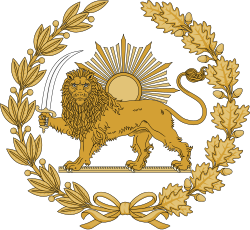사파비 왕조

| |
| 국가 | 대이란국 |
|---|---|
| 작위 | 대이란국의 샤한샤 |
| 설립자 | 이스마일 1세 |
| 설립일 | 1501년 |
| 폐위일 | 1736년 |
| 민족 | 페르시아인 |
사파비 왕조(/ˈsæfəvɪd,
사파비 왕조는 1501년부터 1722년까지 통치하였고(1729~1736년, 1750~1773년 잠시 복구되었음), 현재 이란, 아제르바이잔, 바레인, 아르메니아, 조지아 동부, 러시아•이라크•쿠웨이트•아프가니스탄을 포함한 북코카서스 일부, 터키, 시리아, 파키스탄, 투르크메니스탄, 우즈베키스탄을 통치하였다.
1736년 멸망하였지만, 이들의 유산은 동서간 경제 요충지로서 이란의 부흥이었고, 효율적인 국가의 수립이었으며, 견제와 균형에 기반을 둔 관료제, 건축학적 혁신, 예술 후원 등이다.[3] 사파비 왕조는 오늘날 열두 이맘파 시아파를 이란 국교로 만든 것도 이들의 유산이며, 중동, 중앙아시아, 코카서스, 아나톨리아, 페르시아만, 메소포타미아 시아파 확산도 공헌했다.[3][5]
사파비왕조 샤(Shah)
[편집]
- 이스마일 1세(Ismail I, 재위 1501–1524)
- 타흐마스프 1세(Tahmasp I, 재위 1524–1576)
- 이스마일 2세(Ismail II, 재위 1576–1578)
- 모하마드 호다반다(Mohammad Khodabanda, 재위 1578–1587)
- 압바스 1세(Abbas I, 재위 1587–1629)
- 사피(Safi, 재위 1629–1642)
- 압바스 2세(Abbas II, 재위 1642–1666)
- 술레이만 1세(Suleiman I, 재위 1666–1694)
- 솔탄 호세인(Soltan Hoseyn, 재위 1694–1722)
- 타흐마스프 2세(Tahmasp II, 재위 1722–1732)
- 압바스 3세(Abbas III, 재위 1732–1736)
같이 보기
[편집]각주
[편집]- ↑ *Afšār, ta·līf-i Iskandar Baig Turkmān. Zīr-i naẓar bā tanẓīm-i fihristhā wa muqaddama-i Īraǧ (2003). 《Tārīkh-i ʻʻālamārā-yi ʻʻAbbāsī》 (페르시아어) Čāp-i 3.판. Tihrān: Mu·assasa-i Intišārāt-i Amīr Kabīr. 17, 18, 19, 79쪽. ISBN 978-964-00-0818-8.
- p. 17: dudmān-i safavīa
- p. 18: khāndān-i safavīa
- p. 19: sīlsīla-i safavīa
- p. 79: sīlsīla-i alīa-i safavīa
- ↑ 〈SAFAVID DYNASTY〉. 《Encyclopædia Iranica》.
- ↑ 가 나 다 Matthee, Rudi (2017년 6월 13일) [28 July 2008]. 〈SAFAVID DYNASTY〉. 《Encyclopædia Iranica》. New York: Columbia University. doi:10.1163/2330-4804_EIRO_COM_509. ISSN 2330-4804. 2022년 5월 25일에 원본 문서에서 보존된 문서. 2022년 6월 23일에 확인함.
- ↑ Streusand, Douglas E., Islamic Gunpowder Empires: Ottomans, Safavids, and Mughals (Boulder, Col : Westview Press, 2011) ("Streusand"), p. 135.
- ↑ 가 나 Savory, Roger (2012) [1995]. 〈Ṣafawids〉. Bosworth, C. E.; van Donzel, E. J.; Heinrichs, W. P.; Lewis, B.; Pellat, Ch.; Schacht, J. 《Encyclopaedia of Islam, Second Edition》 8. Leiden and Boston: Brill Publishers. doi:10.1163/1573-3912_islam_COM_0964. ISBN 978-90-04-16121-4.
- ↑ Baltacıoğlu-Brammer, Ayşe (2021). 〈The emergence of the Safavids as a mystical order and their subsequent rise to power in the fourteenth and fifteenth centuries〉. Matthee, Rudi. 《The Safavid World》. Routledge Worlds 1판. New York and London: Routledge. 15–36쪽. doi:10.4324/9781003170822. ISBN 978-1-003-17082-2. S2CID 236371308.
- ↑
- Matthee, Rudi. (2005). The Pursuit of Pleasure: Drugs and Stimulants in Iranian History, 1500-1900. Princeton University Press. p. 18; "The Safavids, as Iranians of Kurdish ancestry and of nontribal background (...)".
- Savory, Roger. (2008). "EBN BAZZĀZ". Encyclopaedia Iranica, Vol. VIII, Fasc. 1. p. 8. "This official version contains textual changes designed to obscure the Kurdish origins of the Safavid family and to vindicate their claim to descent from the Imams."
- Amoretti, Biancamaria Scarcia; Matthee, Rudi. (2009). "Ṣafavid Dynasty". In Esposito, John L. (ed.) The Oxford Encyclopedia of the Islamic World. Oxford University Press. "Of Kurdish ancestry, the Ṣafavids started as a Sunnī mystical order (...)"
- ↑
- Roemer, H.R. (1986). "The Safavid Period" in Jackson, Peter; Lockhart, Laurence. The Cambridge History of Iran, Vol. 6: The Timurid and Safavid Periods. Cambridge University Press. pp. 214, 229
- Blow, David (2009). Shah Abbas: The Ruthless King Who Became an Iranian Legend. I.B.Tauris. p. 3
- Savory, Roger M.; Karamustafa, Ahmet T. (1998) ESMĀʿĪL I ṢAFAWĪ. Encyclopaedia Iranica Vol. VIII, Fasc. 6, pp. 628-636
- Ghereghlou, Kioumars (2016). ḤAYDAR ṢAFAVI. Encyclopaedia Iranica
- ↑ Aptin Khanbaghi (2006) The Fire, the Star and the Cross: Minority Religions in Medieval and Early. London & New York. IB Tauris. ISBN 1-84511-056-0, pp. 130–1
- ↑ Yarshater 2001, 493쪽.
- ↑ Khanbaghi 2006, 130쪽.
- ↑ Anthony Bryer. "Greeks and Türkmens: The Pontic Exception", Dumbarton Oaks Papers, Vol. 29 (1975), Appendix II "Genealogy of the Muslim Marriages of the Princesses of Trebizond"
- ↑ 사파비 왕조 - 이란 백과사전, "The origins of the Safavids are clouded in obscurity. They may have been of Kurdish origin (see R. Savory, Iran Under the Safavids, 1980, p. 2; R. Matthee, "Safavid Dynasty" at iranica.com), but for all practical purposes they were Turkish-speaking and Turkified."
- ↑ Why is there such confusion about the origins of this important dynasty, which reasserted Iranian identity and established an independent Iranian state after eight and a half centuries of rule by foreign dynasties? RM Savory, Iran under the Safavids (Cambridge University Press, Cambridge, 1980), p. 3.
- ↑ Alireza Shapur Shahbazi (2005), "The History of the Idea of Iran", in Vesta Curtis ed., Birth of the Persian Empire, IB Tauris, London, p. 108: "Similarly the collapse of Sassanian Eranshahr in AD 650 did not end Iranians' national idea. The name "Iran" disappeared from official records of the Saffarids, Samanids, Buyids, Saljuqs and their successor. But one unofficially used the name Iran, Eranshahr, and similar national designations, particularly Mamalek-e Iran or "Iranian lands", which exactly translated the old Avestan term Ariyanam Daihunam. On the other hand, when the Safavids (not Reza Shah, as is popularly assumed) revived a national state officially known as Iran, bureaucratic usage in the Ottoman empire and even Iran itself could still refer to it by other descriptive and traditional appellations".
외부 링크
[편집] 위키미디어 공용에 사파비 왕조 관련 미디어 분류가 있습니다.
위키미디어 공용에 사파비 왕조 관련 미디어 분류가 있습니다.
| 이 글은 역사에 관한 토막글입니다. 여러분의 지식으로 알차게 문서를 완성해 갑시다. |
